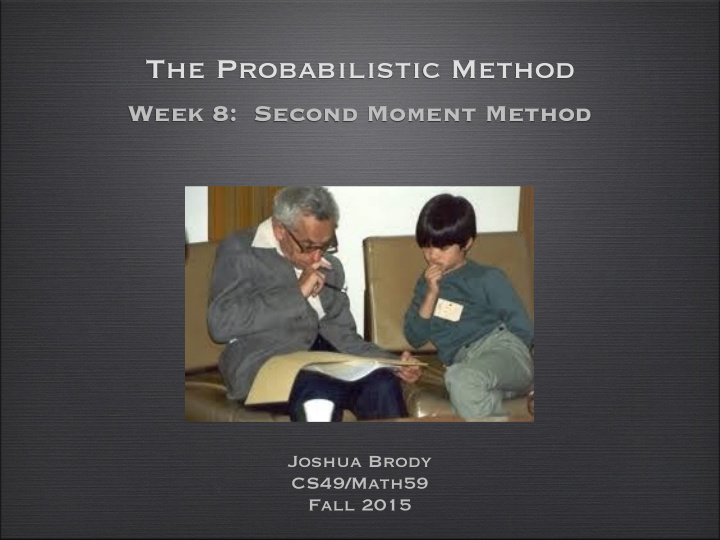



The Probabilistic Method Week 8: Second Moment Method Joshua Brody CS49/Math59 Fall 2015
Reading Quiz What is Cov[X,Y]? (A) Cov[X,Y] = E[X]E[Y] - E[XY] (B) Cov[X,Y] = E[XY] - E[X]E[Y] (C) Cov[X,Y] = E[(X-E[X])2] (D) Cov[X,Y] = Var[XY] - E[XY] (E) None of the above
Reading Quiz What is Cov[X,Y]? (A) Cov[X,Y] = E[X]E[Y] - E[XY] (B) Cov[X,Y] = E[XY] - E[X]E[Y] (C) Cov[X,Y] = E[(X-E[X])2] (D) Cov[X,Y] = Var[XY] - E[XY] (E) None of the above
Reading Quiz About how many prime factors does a typical integer n have? (A) √ n (B) log(n) (C) ln(ln n) (D) log(ln(ln n)) (E) None of the above
Reading Quiz About how many prime factors does a typical integer n have? (A) √ n (B) log(n) (C) ln(ln n) (D) log(ln(ln n)) (E) None of the above
Moments kth central moment: E[(X-E[X]) k ] (1) expected value: E[X] (2) variance: E[(X-E[X]) 2 ] (3) skewness: E[(X-E[X]) 3 ] (4) ...
The First Moment Method Most previous techniques use First Moment Method Basic Method: as First Moment Method: (1) Define bad events BAD i (2) BAD := ∪ i BAD i (3) bound Pr[BADi] ≤ 휹 (4) Compute # bad events ≤ m (5) union bound: Pr[BAD] ≤ m 휹 < 1 (6) ∴ Pr[GOOD] > 0
The First Moment Method Most previous techniques use First Moment Method Basic Method: as First Moment Method: (1) Define bad events BAD i (1) Z i : indicator var for BAD i (2) BAD := ∪ i BAD i (2) Z := ∑ i Z i (3) E[Z i ] = Pr[BAD i ] ≤ 휹 (3) bound Pr[BADi] ≤ 휹 (4) Compute # bad events ≤ m (4) Compute # bad events ≤ m (5) union bound: (5) E[Z] = E[Z i ] ≤ m 휹 < 1 Pr[BAD] ≤ m 휹 < 1 (6) ∴ Z = 0 w/prob > 0 (6) ∴ Pr[GOOD] > 0
Clicker Question Let X,Y be fair coins. What is Cov[X,Y] when (i) X = Y (ii) X = 1-Y (A) (i) 1/4 (ii) -1/4 (B) (i) 1/2 (ii) -1/2 (C) (i) -1/4 (ii) 1/4 (D) (i) 1/4 (ii) 1/4 (E) (i) -1/2 (ii) -1/2
Clicker Question Let X,Y be fair coins. What is Cov[X,Y] when (i) X = Y (ii) X = 1-Y (A) (i) 1/4 (ii) -1/4 (B) (i) 1/2 (ii) -1/2 (C) (i) -1/4 (ii) 1/4 (D) (i) 1/4 (ii) 1/4 (E) (i) -1/2 (ii) -1/2
Most Integers Have ln(ln(n)) Prime Factors Theorem: Let g(n) be a function growing arbitrarily slowly. Then, there are o(n) integers x ≤ n such that | ν (x) - ln(ln(n))| > g(n) √ ln(ln(n))
Most Integers Have ln(ln(n)) Prime Factors Theorem: Let g(n) be a function growing arbitrarily slowly. Then, there are o(n) integers x ≤ n such that | ν (x) - ln(ln(n))| > g(n) √ ln(ln(n)) Proof: • Take random x ∈ [n] • Estimate # distinct primes dividing x • Use Chebyshev to bound deviation.
The Probabilistic Method
Recommend
More recommend